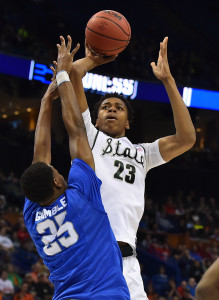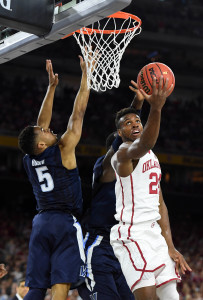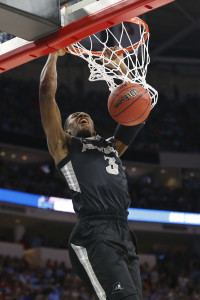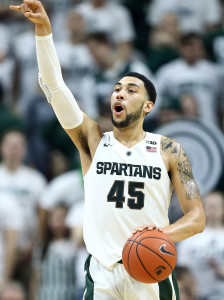Stanley Johnson arrived at Arizona coming off four straight high school state championships and was regarded by many scouts as the best wing prospect in the nation. While the freshman didn’t quite live up to the hype, he had a solid 2014/15 campaign, and led the Wildcats in scoring last season. But a lackluster NCAA tournament and some holes in his game have dampened NBA scouts’ projections for Johnson a bit. Instead of a potential superstar, the 19-year-old is now being looked at as more of a solid rotation player.
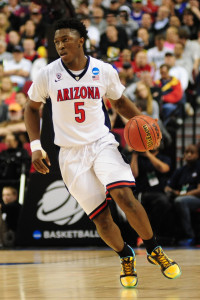
Courtesy of USA Today Sports Images
The forward’s draft stock has fluctuated over the course of the season. He was projected as a possible top five pick earlier in the year, but is now more likely to hear his name called on draft night toward the end of the lottery. Jonathan Givony of DraftExpress ranks Johnson as the No. 8 player available, while Chad Ford of ESPN.com (Insider subscription required) slots him at No. 11.
“I want to love him,” one NBA GM told Fran Fraschilla of ESPN.com. “My scouts all loved him in high school. I’ve watched him live four times and every time come away with the same thought: ‘He’s pretty good.’ But pretty good isn’t going to make you a great NBA player. He’s a good athlete, a good shooter, a good defender, a good motor. He has a great body but doesn’t always use any of those skills to his advantage. If he were the athlete that [Justise] Winslow was, I’d love him. But he isn’t, and I just feel he’ll be pretty good. If those are your expectations, great. If they’re higher, I think you’re going to be disappointed.”
With the draft full of talented wings, Johnson’s skillset, while solid, doesn’t rise above the rest of the field in any particular area. He’s not as explosive as Winslow, not as good an outside shooter as Mario Hezonja, doesn’t have the upside of Kelly Oubre, nor is Johnson as stellar a defender as his teammate and fellow draft prospect, Rondae Hollis-Jefferson. Johnson is the highest player on the draft board to hit the “safe” category, according to Ford’s profile of the player. “He’s not as good as we thought he’d be coming into things,” one GM told the ESPN scribe. “But he’s not as bad as I think we’ve made him out to be either.” He’ll work hard and if he improves, he’ll be a very good value pick.”
The odd thing about Johnson’s game, especially when discussing him as a potential lottery pick, is how middle-of-the-road he ranks in relation to other small forwards in this year’s draft. According to ESPN.com’s Kevin Pelton, in terms of the core projected statistics he looks at to measure skills, the only one where Johnson is in either the top or bottom 25% among NBA-bound small forwards is his steal rate of 1.5 per contest, or 2.1 per 40 minutes. The rest of his statistics are solid, but not mind-blowing, with Johnson logging 13.8 points, 6.5 rebounds, and 1.7 assists per contest.
Johnson was not considered a great shooter upon entering college, only making 82 of 279 of his 3-point attempts (29%) in high school and AAU events, notes Givony. But he managed to impress NBA scouts with his ability to make shots as a freshman, hitting 41 of his 111 3-point attempts on the season (37%), and showing a much quicker release and more compact mechanics than he had displayed earlier in his career, both shooting off the dribble (he converted 49% of his pull-ups in the half-court) and with his feet set (44% when catching and shooting), notes the DraftExpress scribe. The freshman was solid from the charity stripe, connecting on 74.9% of his free throw attempts.
While Johnson’s improvement from the outside was a boon this season, he doesn’t necessarily project as a 3-and-D player in the NBA. This is where some teams could be scared off from selecting the forward. With his rock solid frame and overall athleticism, Johnson should have been an absolute beast in the paint area while at Arizona. But he was an abysmal finisher in the lane, connecting on only 50% of his attempts around the rim. That is not a great success rate no matter what level of hoops you are playing at, and will be a major source of concern for Johnson when he steps onto the NBA hardwood.
This is not to say that Johnson is an albatross to his team on the offensive end. He has shown that he can create his own shot effectively with his combination of quickness, size and power, Givony notes. Johnson is also a solid ball-handler who can be quite a load to handle in transition, and he is effective in the pick-and-roll, though his failure to connect on shots when beating his man to the rim limits his usage in this capacity.
Johnson’s biggest appeal as a prospect is his potential on the defensive end. He has tremendous physical tools, including great size for his position, a strong frame, solid length, and excellent anticipation skills, adds Givony. The 19-year-old can legitimately defend three positions with his combination of size, speed, and strength, though his intensity wasn’t a constant, and his coaches at Arizona expressed some level of frustration with Johnson’s tendency to take plays off, or letting a poor offensive possession haunt him on the other end of the court. Johnson is also an effective rebounder, notching 9.1 per 40 minutes despite playing out of position at shooting guard for much of his freshman campaign.
The forward’s NBA potential is still a bit murky. Pelton projects Johnson’s ceiling to be that of Luol Deng or Thaddeus Young, with the more pessimistic view being Marvin Williams. The team that selects Johnson this June will be getting a solid player with potential to be in the league for a long time. But the 19-year-old doesn’t appear ticketed for stardom, which will likely drop him out of the top 10 selections. This slight drop could actually be a boon to Johnson’s long-term development, since he isn’t a player who can or will change the face of a franchise. There is significantly less pressure involved, as well as more patience shown, with players taken toward the middle of the first round. Johnson should evolve into a solid rotation piece by his second season, though his rookie campaign will likely entail heavy D-League time.
